In 2018, nearly 25% of Canadians aged 15-24 used cannabis. This fact shows why Canada created strict rules for plant-based products. These rules aim to protect youth and public health.
The federal regulations set clear limits for moving products through the supply chain. They help keep substances from youth and stop criminal profits. These guidelines also protect public health.
These rules show how the Canadian market works legally. They create specific paths for products to move from makers to buyers. The framework keeps strict control over this process.
These distribution parameters are key for anyone in the sector. They form the base of lawful operations. Local authorities can adjust these rules to fit their needs.
This structure balances adult access with community safety. It shapes every part of the Canadian marketplace. The next sections will explain these guidelines in detail.
Understanding the Cannabis Act Framework
The Cannabis Act framework balances public health with distribution considerations. It sets guidelines for the legal cannabis supply chain. The law also addresses social and criminal justice concerns.
This landmark legislation created a comprehensive system for cannabis distribution. It examines complex historical, legal, and jurisdictional elements. These factors shape Canada’s approach to legal cannabis distribution.
Historical Context of Cannabis Legalization in Canada
Canada’s cannabis legalization journey began long before the Cannabis Act. In 2001, medical cannabis access was authorized through the Marihuana Medical Access Regulations. This laid the groundwork for a regulated system.
Court challenges and regulatory updates followed in the early 2000s. In 2015, the Liberal government promised recreational cannabis legalization. This marked a significant shift in the political landscape.
The Cannabis Act received Royal Assent on June 21, 2018. It came into force on October 17, 2018. Canada became the first G7 nation to fully legalize recreational cannabis federally.
Key Objectives of the Cannabis Act
The Cannabis Act has three primary objectives that guide distribution regulations. It aims to keep cannabis away from youth through strict access controls. Age verification is required throughout the distribution chain.
The Act establishes legal pathways for cannabis production and distribution. This keeps profits away from criminals and addresses the illicit market. It also protects public health by allowing adults access to regulated cannabis products.
Quality standards, testing requirements, and tracking systems are implemented throughout distribution. These measures ensure the safety and quality of cannabis products for consumers.
Federal vs. Provincial Jurisdiction
Canada’s cannabis framework divides regulatory authority between federal and provincial governments. This creates a unique landscape for cannabis distribution. The federal government sets the overarching framework through the Cannabis Act.
Federal responsibilities include production licensing, product standards, and criminal penalties. Provinces and territories determine specific distribution models within their jurisdictions. This shared responsibility approach allows for regional adaptation.
| Regulatory Area | Federal Responsibility | Provincial Responsibility |
|---|---|---|
| Production Licensing | Full authority | Limited or no authority |
| Distribution Models | Framework guidelines | Full implementation authority |
| Retail Operations | Minimum standards | Licensing and regulation |
| Age Requirements | Minimum age (18) | Setting specific age (19-21) |
| Possession Limits | Maximum thresholds | Can set lower limits |
This jurisdictional split has led to varied distribution systems across Canada. Some provinces have government-controlled monopolies. Others allow private sector involvement in cannabis distribution. Understanding these differences is crucial for those involved in Cannabis Act distribution.
Legal Definition of Cannabis Distribution Under the Act
Canada’s Cannabis Act defines how cannabis distribution is regulated. It outlines specific rules for different activities in the cannabis supply chain. Knowing these definitions is crucial for following federal regulations.
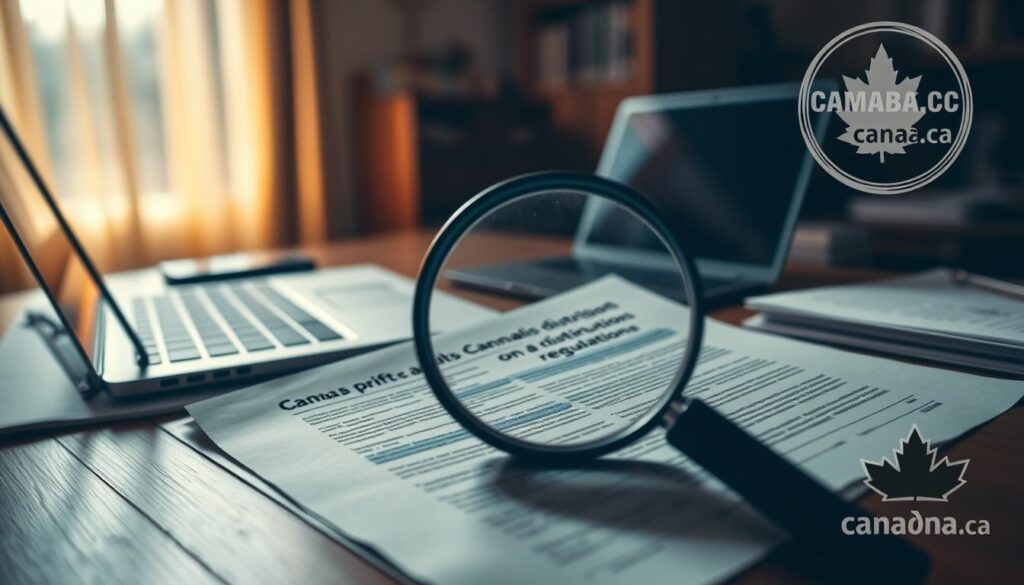
What Constitutes Distribution
The Cannabis Act defines distribution as moving cannabis between licensed entities. This includes transporting products from growers to processors and from processors to testing labs. It also covers moving products to wholesalers or retailers.
Distribution must follow strict cannabis distribution regulations. These rules cover secure transport, proper paperwork, and product tracking. Compliance with these regulations is essential for all distribution activities.
Distinguishing Between Distribution and Sale
Distribution and retail sale are different under the Cannabis Act. Distribution involves business-to-business transactions within the supply chain. Retail sale means selling cannabis products directly to consumers.
Each activity has its own licensing requirements and operational rules. Understanding this difference is key for knowing which regulations apply to your business.
Criminal Code Implications for Unauthorized Distribution
Operating outside legal distribution rules has serious consequences. The Cannabis Act and Criminal Code set penalties for unauthorized distribution. These target those working outside the law, especially organized crime.
Penalties range from warnings for minor violations to jail time for serious offenses. The Act is particularly strict about making cannabis available to youth. This reflects the law’s goal of protecting young Canadians.
Understanding these rules is vital for any cannabis distribution business. It ensures full compliance with the law and avoids severe penalties.
Federal Licensing Requirements for Cannabis Distribution
Understanding federal licensing is crucial for legal cannabis distribution in Canada. The Cannabis Act created a strict framework for safe and secure operations. Getting the right license is your first step to legal operation.
This tightly controlled industry ensures all activities meet public health goals. Proper licensing allows you to participate in the legal cannabis distribution chain.
Types of Distribution Licenses
Health Canada offers several licenses for cannabis distribution activities. Each license type matches specific operations in the supply chain.
- Standard Processing License – Permits large-scale processing of cannabis into various products
- Micro-Processing License – Allows smaller-scale processing operations with reduced regulatory requirements
- Sale for Medical Purposes License – Enables distribution directly to registered medical patients
- Analytical Testing License – Required for facilities testing cannabis products
- Research License – Permits distribution of cannabis for research purposes
Your business model will decide which license you need. Many distributors need multiple licenses to cover all their activities.

Application Process and Eligibility Criteria
The licensing process is thorough and demanding. You must submit detailed documents through Health Canada’s Cannabis Tracking and Licensing System.
Key application parts include:
- Site details and floor plans of your facility
- Security plans that meet federal requirements
- Standard operating procedures for cannabis inventory management
- Quality assurance reports and product safety measures
- Record-keeping systems that ensure compliance
Health Canada reviews applications based on public health and safety standards. The process can take several months, depending on complexity.
Security Clearance Requirements
Key personnel in cannabis distribution must get security clearances. These checks help keep criminals out of the legal market.
Background Checks
Directors, officers, and key staff must undergo thorough background checks. These look at criminal records, past associations, and links to organized crime.
Any history of drug trafficking or serious offenses may disqualify an applicant. These checks ensure only trustworthy individuals enter the industry.
Financial Disclosure
The licensing process requires detailed financial information. This includes:
- Sources of capital investment
- Corporate structure and ownership details
- Financial statements and funding arrangements
- Disclosure of all major shareholders and investors
These disclosures help regulators ensure all funding is legitimate. They also check if your operation can stay financially viable.
This process supports proper cannabis retail licensing compliance. It keeps the industry transparent and accountable.
Cannabis Act – Distribution Compliance Framework
Canada’s Cannabis Act sets rules for product safety and market integrity. The Cannabis Regulations govern production, distribution, and sale of cannabis products. Distributors must follow these rules while managing their operations.
Robust systems are essential to maintain compliance with these regulations. This framework ensures that distributors meet all necessary requirements.
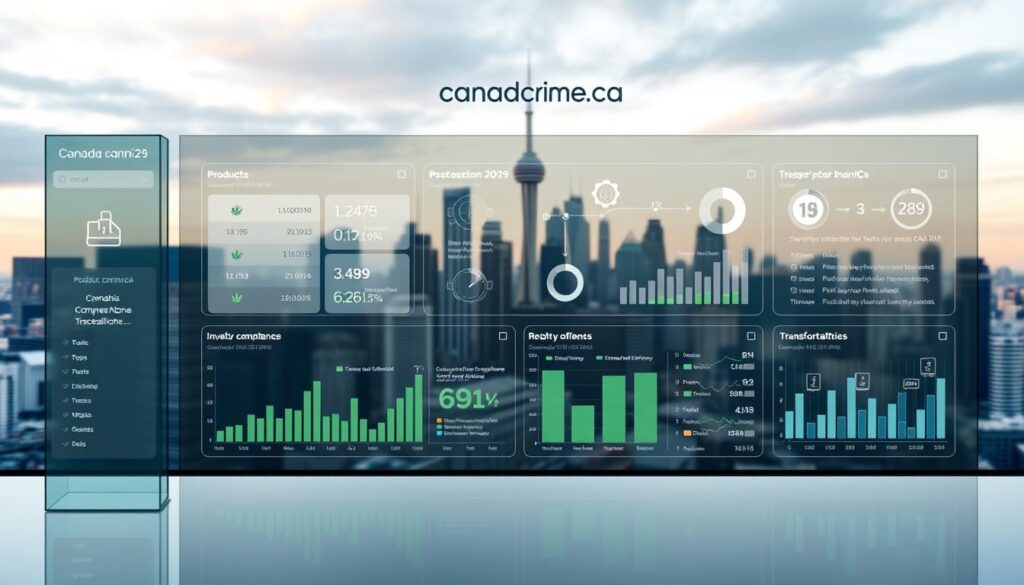
Record-Keeping Requirements
Cannabis inventory management requires careful record-keeping. You must track all cannabis entering and leaving your facility. These records form the core of your compliance program.
Your record-keeping system should include:
- Complete inventory records with batch and lot numbers
- Sales documentation with purchaser information
- Transportation manifests and chain of custody logs
- Security incident reports and resolution documentation
Store all records securely for at least two years. Make them easily accessible for regulatory inspections. Digital systems for cannabis product traceability are becoming standard.
Reporting Obligations to Health Canada
You must submit regular reports to Health Canada. Monthly inventory reports cover all cannabis received, produced, sold, and destroyed. Submit these within 15 days after each month ends.
Annual compliance reports overview your operations. Submit these within three months after your fiscal year ends. Report any theft, loss, or security breach within 10 days.
Quality Assurance and Testing Standards
Maintain Good Production Practices (GPP) throughout your supply chain. This includes proper storage, contamination prevention, and handling procedures. These practices help preserve product integrity.
Contaminant Testing
All cannabis products must undergo thorough testing for harmful substances. Screen for microbial contaminants like E. coli and Salmonella. Test for chemical residues from pesticides and heavy metals like lead and mercury.
Potency Verification
Verify that THC and CBD content matches product labeling. Conduct periodic testing to confirm potency levels stay within acceptable limits. Quarantine and possibly destroy products with significant potency deviations.
Provincial Distribution Models Across Canada
Canada’s cannabis distribution systems showcase diverse regulatory approaches. The Cannabis Act sets federal guidelines, but provinces have developed their own frameworks. They can add safety measures like raising the minimum age and limiting public consumption.
Provinces oversee the legal cannabis supply chain differently. Some use government monopolies, while others allow private enterprise. These varied models create a complex landscape for cannabis businesses across Canada.

Government-Controlled Distribution Systems
Some provinces use crown corporations to control cannabis wholesale distribution. Quebec’s SQDC and Nova Scotia’s NSLC are examples of public monopolies throughout the supply chain.
In these models, the crown corporation is the sole buyer from producers and supplier to retailers. This approach allows strict oversight of product quality and comprehensive inventory tracking.
Private Distribution Models
Saskatchewan leads with a private distribution model. Licensed companies can wholesale without government intermediaries. This creates a direct link between producers and retailers.
Private models typically feature:
- Competitive pricing structures
- Greater product selection flexibility
- More responsive inventory management
- Streamlined supply chain relationships
Hybrid Approaches
Most provinces use hybrid models combining public and private systems. These often have government control over wholesale distribution with private sector retail involvement.
British Columbia and Ontario exemplify this balanced approach. They maintain government oversight of wholesale distribution while allowing private retailers to operate.
Case Studies: Ontario, Alberta, and Quebec
Ontario’s Cannabis Store (OCS) has exclusive wholesale rights while licensing private retailers. This system balances government control with retail competition and innovation.
Alberta’s AGLC is the sole wholesaler, supplying a vast network of private retailers. This model ensures widespread retail access while maintaining strict provincial oversight.
Quebec’s SQDC controls both wholesale and retail operations. This government-controlled system prioritizes public health over commercial interests. It limits product selection and maintains higher prices.
These diverse approaches create complexity for businesses in the legal cannabis supply chain. Understanding regional differences is key for compliance and planning in Canada’s cannabis industry.
Wholesale Operations and Supply Chain Management
Wholesale operations are vital in the legal cannabis supply chain. They connect licensed producers with retailers through regulated channels. The Cannabis Act sets guidelines for business-to-business transactions, accommodating provincial distribution models.
Understanding these regulations is crucial for anyone in the commercial cannabis sector. The framework ensures clear guidelines for all parties involved.
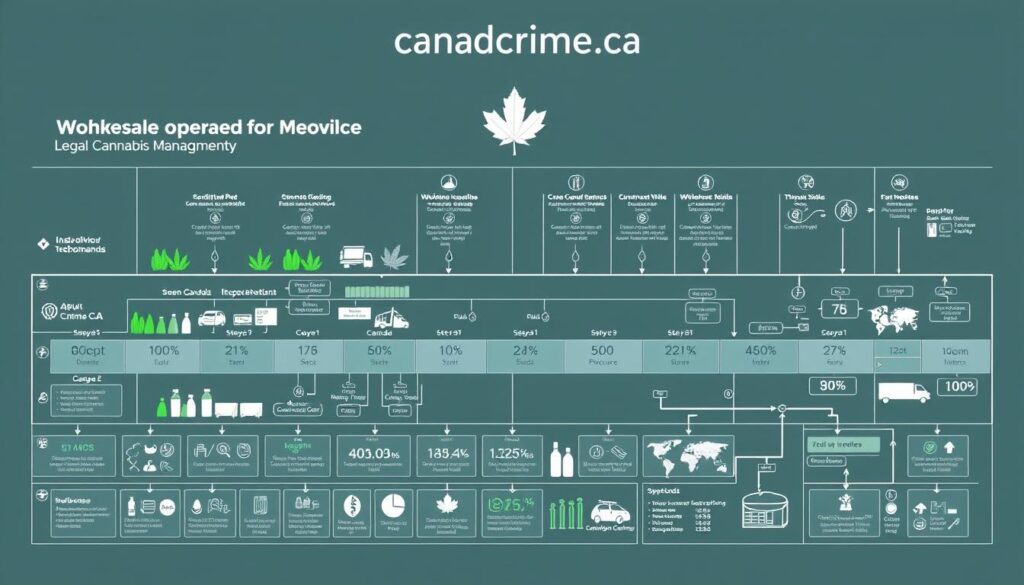
B2B Distribution Regulations
Strict regulatory oversight governs business-to-business cannabis distribution in Canada. Rules vary by province. Licensed producers must keep detailed records of all wholesale transactions.
Health Canada mandates seed-to-sale tracking systems for all wholesale distributors. These systems monitor cannabis products throughout the supply chain. Wholesale operators must verify their partners’ licenses before transactions.
Pricing Structures and Taxation
The cannabis wholesale market faces a complex taxation framework. This significantly impacts pricing strategies. Federal excise duty applies to all cannabis products.
Provincial distribution boards often set standardized pricing models. These determine wholesale costs. Some provinces have fixed margins, while others allow market-driven pricing.
| Province | Wholesale Model | Pricing Structure | Typical Markup |
|---|---|---|---|
| Ontario | Government Monopoly | Fixed Margin | 15-20% |
| Alberta | Government Distributor | Cost-Plus | 15% |
| Saskatchewan | Private Wholesale | Market-Driven | Variable (10-25%) |
| Quebec | Government Monopoly | Fixed Margin | 23% |
Supplier Agreements and Contracts
Effective supplier agreements are crucial in cannabis supply chain management. These contracts must address regulatory compliance and establish clear business terms. Key contractual elements include product specs, quality standards, and delivery schedules.
Most agreements include provisions for regulatory changes. They specify testing requirements and procedures for handling non-compliant products.
Exclusivity clauses are common in the maturing market. Some producers secure preferred supplier status with distributors. These arrangements must comply with competition laws while providing stability.
Packaging, Labeling, and Product Requirements
The Cannabis Act sets strict rules for cannabis product packaging and labeling. These rules protect consumers and limit youth appeal. They ensure consistent standards and provide essential information to buyers.
Cannabis products must meet rigorous requirements throughout the distribution chain. This helps maintain quality and safety for all consumers.
Child-Resistant Packaging Standards
All cannabis products in Canada need child-resistant containers. These containers must meet specific technical requirements. The standards vary by product type but prevent easy opening by young children.
Child-resistant packaging undergoes testing to verify its effectiveness. Distributors must keep proof that their packaging meets these rules.
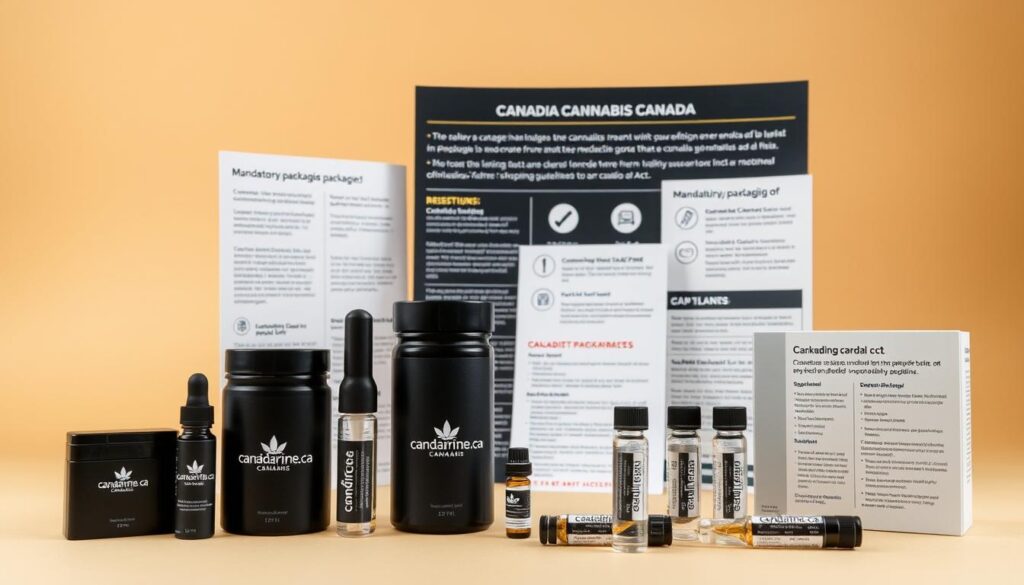
Required Warning Labels
Every cannabis product must show health warnings in English and French. These warnings appear in a specific size and format. They’re usually in a yellow box for visibility.
A red stop sign with a cannabis leaf and “THC” must be on all THC products. This symbol quickly shows that the product contains cannabis.
Distributors ensure warning labels stay readable throughout the supply chain. This supports proper cannabis product tracing.
THC/CBD Content Disclosure
All cannabis products must show accurate potency information. Labels must clearly indicate:
- Total THC content
- Total CBD content
- Equivalency factors for non-dried forms
Testing verifies potency claims fall within acceptable ranges. Distributors have plans for products outside these ranges, including possible recalls.
Plain Packaging Requirements
The Cannabis Act limits product appearance to reduce youth appeal. Packaging must be one solid color without metallic or fluorescent finishes.
Brand elements have strict size and placement rules. This helps keep the focus on safety, not marketing.
| Packaging Element | Restrictions | Permitted Elements | Compliance Verification |
|---|---|---|---|
| Colors | Single, uniform color only | Matte finish in neutral tones | Visual inspection |
| Logos/Branding | Limited to one brand element | Small logo (≤ 1.5 cm²) | Size measurement |
| Images/Graphics | No lifestyle imagery | Standardized cannabis symbol | Content review |
| Text | No health claims | Required warnings and information | Text analysis |
Transportation and Logistics Regulations
Canada’s Cannabis Act sets rules for moving cannabis products. These rules keep cannabis secure from producer to retailer. They prevent illegal sales and maintain product quality.
Secure Transport Requirements
The Cannabis Act requires specific security measures for cannabis transport vehicles. Licensed distributors must use climate-controlled vehicles with tamper-evident seals. These vehicles need GPS tracking for real-time location data.
Vehicles must follow pre-approved routes with few stops. Any route changes need documentation and justification. Emergency plans are required for breakdowns or accidents.

Documentation and Manifests
Every cannabis shipment needs detailed paperwork. This includes inventory lists, custody records, and transport permits. Sender and recipient contact info is also required.
Documents must stay with the shipment for inspections. Both sender and recipient keep electronic copies for two years.
Inter-Provincial Movement Restrictions
Moving cannabis across provinces has extra rules. Each province has its own requirements for incoming cannabis. This creates complex compliance issues for multi-region distributors.
Some provinces need advance notice for cannabis shipments. Others have specific entry points for deliveries. Cross-province services must get permits from each area they serve.
Vehicle and Personnel Security Measures
Cannabis transport staff need strict security clearances. Drivers and security undergo background checks and special training. They learn cannabis handling and emergency response.
Vehicles must have locked cannabis storage areas. These areas stay closed during transit. Many distributors use two-person teams for valuable shipments.
Retail Distribution Compliance
Canadian cannabis retailers must follow strict distribution rules. These cover location, training, and age checks. The rules ensure responsible sales and protect minors. Retailers must meet federal and provincial standards.
Store Location Restrictions
Cannabis stores face location limits to reduce youth exposure. Most provinces set minimum distances from sensitive areas. These include schools, playgrounds, and other cannabis stores.
Buffer zones vary across provinces and cities. Ontario requires 150 meters from schools. Alberta needs 100 meters. Local laws may add more rules.
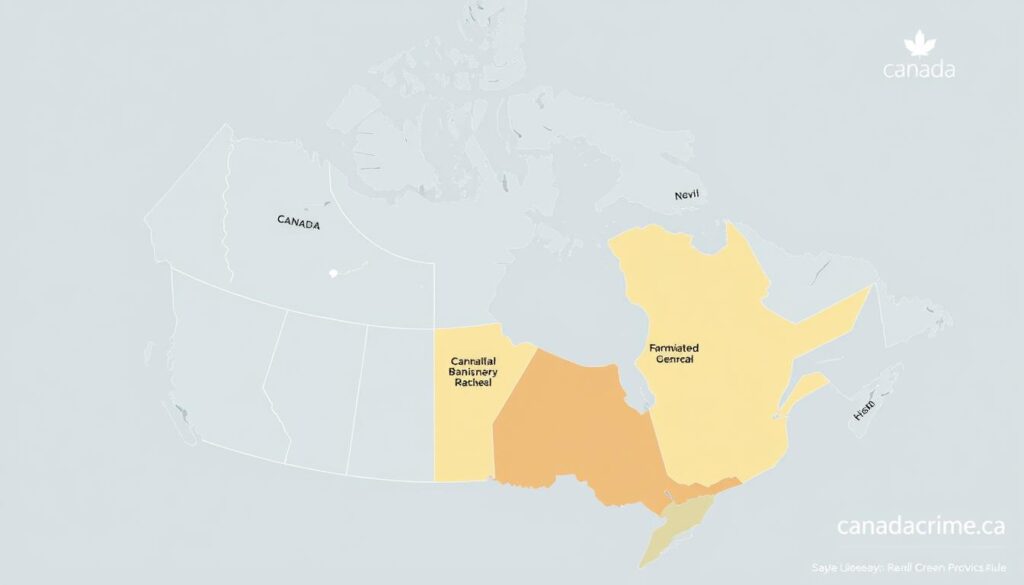
Staff Training Requirements
Cannabis retail workers must complete training before serving customers. Programs cover product knowledge, impairment signs, and legal duties. They also teach proper ID checking.
Provinces often require specific certifications. British Columbia uses the Selling It Right program. Alberta needs SellSafe Cannabis Staff Training.
Age Verification Protocols
The Cannabis Act bans selling to anyone under 18. Penalties for violations can reach 14 years in jail. This includes direct sales and using minors in cannabis crimes.
Retailers must use strict age checks. They check IDs for anyone looking under 25. Staff learn to spot fake IDs. Stores keep records of these checks.
Online Sales Verification Methods
Cannabis e-commerce platforms use strong age-checking tech. This prevents underage access. Methods include multi-step checks and ID validation at delivery.
Some provinces use government delivery services. Others allow private couriers meeting security rules. Online sellers must keep detailed verification records.
Penalties and Enforcement for Distribution Violations
Breaking cannabis distribution rules in Canada can lead to serious consequences. The Cannabis Act sets penalties based on how bad the violation is. These consequences ensure companies follow the rules and keep people safe.
Anyone in the cannabis supply chain needs to understand these potential penalties. They help maintain regulatory compliance and public safety in the industry.
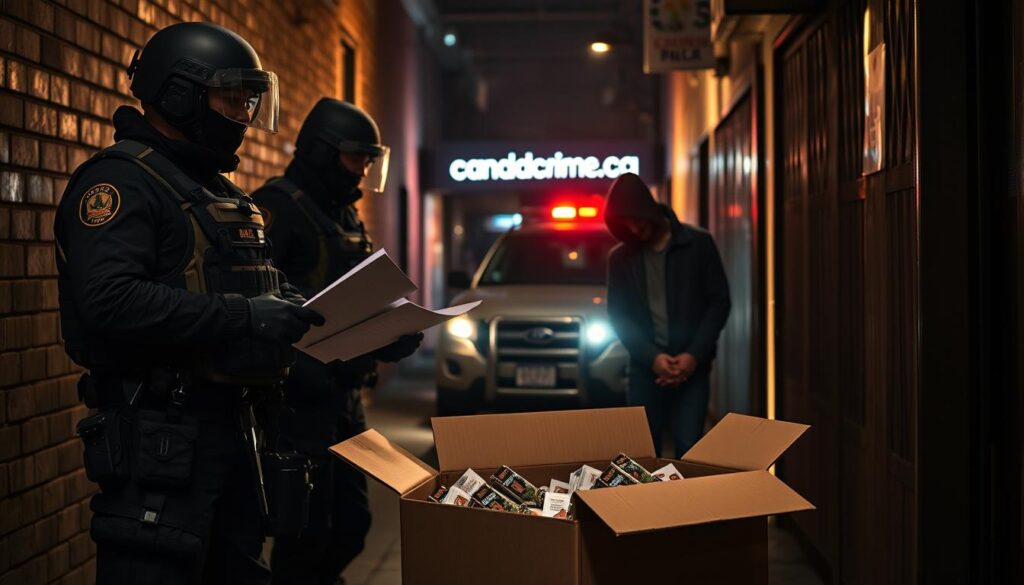
Administrative Monetary Penalties
Health Canada uses fines for less severe rule breaks. These fines, called AMPs, can range from $250 to $1,000,000. The amount depends on the type of violation and past behavior.
Several factors affect the penalty amount. These include the distributor’s history, money made from breaking rules, and efforts to fix the problem.
- The distributor’s compliance history
- Economic benefit gained from the violation
- Efforts made to mitigate or reverse the violation
- Cooperation with regulatory authorities
Criminal Sanctions Under the Cannabis Act
More serious violations can lead to criminal charges. This happens when activities are outside the law or involve organized crime. The Cannabis Act focuses on offenses that risk public health or make cannabis available to youth.
Criminal penalties can be severe. They include large fines and jail time for illegal distribution or sale.
- Fines up to $5 million for illegal distribution or sale
- Imprisonment ranging from 14 days to 14 years
- Enhanced penalties for involving minors in cannabis-related offenses
- Additional sanctions for cross-border transportation violations
License Suspension and Revocation Processes
Health Canada can suspend or revoke distribution licenses for serious or repeated violations. This can happen quickly if public safety is at risk. It’s a powerful tool to enforce cannabis transportation rules.
Appeal Procedures
Distributors can appeal enforcement actions through a structured process. It starts with an administrative review within 30 days of getting a violation notice. If that fails, they can request formal tribunal hearings.
Remediation Options
After facing penalties, distributors can take steps to improve. They can show they’re following rules better and fix problems.
- Implementing enhanced compliance monitoring systems
- Developing comprehensive corrective action plans
- Demonstrating improved operational procedures
- Completing additional staff training on regulatory requirements
Conclusion: Navigating Canada’s Cannabis Distribution Landscape
The Cannabis Act provides a framework for cannabis movement in Canada’s supply chain. Understanding these rules helps you navigate legal cannabis distribution. It supports the Act’s goals of youth protection and public health.
Compliance is key for successful cannabis operations. Proper documentation, security, and quality control are essential. Penalties for violations can be severe, including fines and license revocation.
The cannabis distribution landscape is evolving with new technology. E-commerce platforms are changing how products reach consumers. Licensed delivery services offer convenience within provincial rules.
Provincial differences in distribution models require location-specific strategies. Quebec has government-controlled systems, while Alberta has private retail models. Knowing your regional requirements is crucial for success.
Staying informed about regulatory updates is important. It helps you adapt to changes and find new opportunities. The cannabis industry is strictly regulated but promising.

